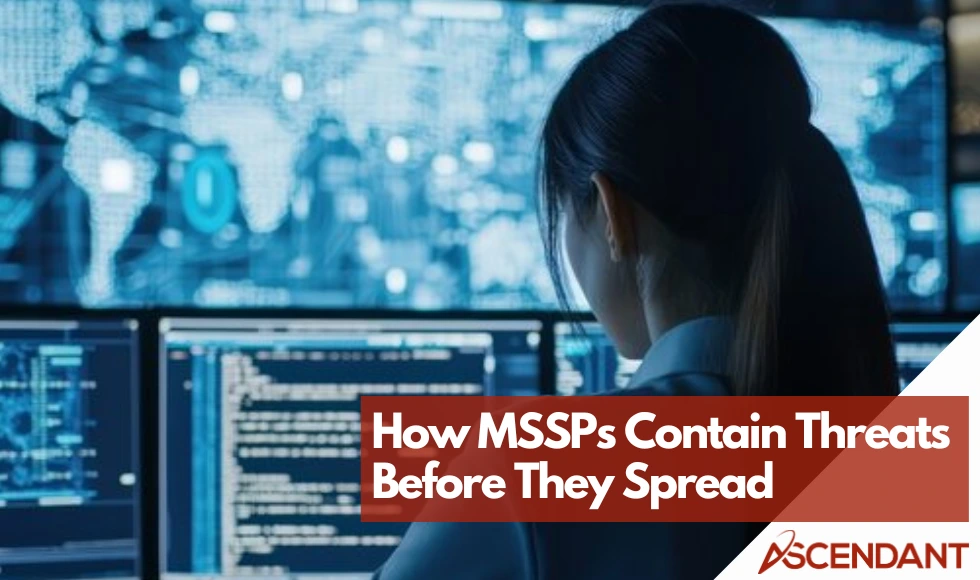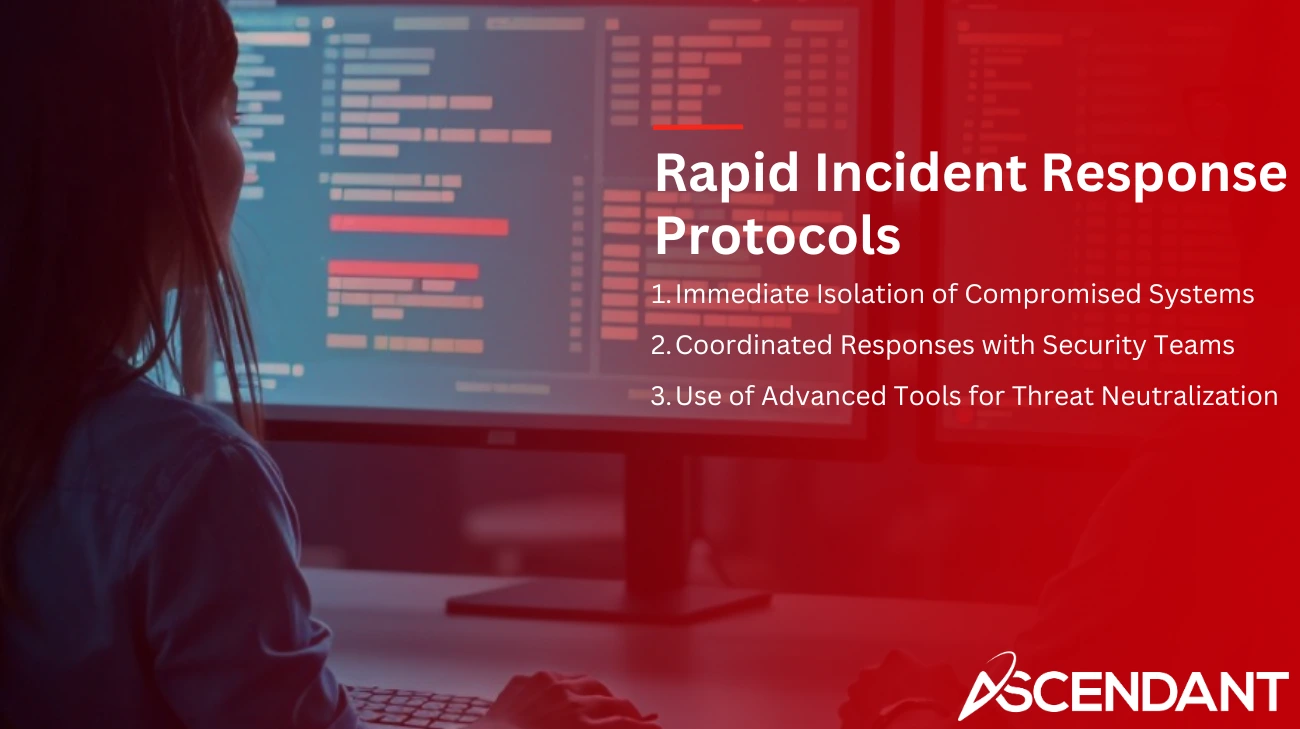Managed Security Service Providers (MSSPs) stop threats in their tracks by using real-time threat detection, continuous monitoring and rapid response protocols. This article explains how MSSPs stop threats by using these methods to protect client networks.
Key Points
- Early detection and real-time monitoring is key for MSSPs to detect and stop cyber threats before they get out of hand.
- Continuous monitoring and threat intelligence helps MSSPs to proactively hunt for vulnerabilities and respond quickly to incidents.
- Rapid incident response and coordination between MSSPs and internal security teams is essential to stop threats and minimize damage.
In This Article:
-
- Why Early Detection is Key to Threat Containment
- Continuous Monitoring for Proactive Threat Hunting
- Rapid Incident Response Protocols
- Threat Intelligence Platforms
- Endpoint Detection and Response (EDR) Strategies
- Real-Time Analysis and Mitigation
- Cloud Security
- Case Studies: Threat Containment
- Compliance Reporting and Audit Support
- Continuous Improvement
Why Early Detection is Key to Threat Containment
Early detection is the foundation of good security. Catching cyber threats early prevents them from becoming bigger problems, keeps client systems intact. MSSPs live on early detection, they have a competitive edge in the security market through proactive threat hunting and real-time threat monitoring.
Threat Intelligence Feeds play a big role here, providing MSSPs with real-time, context enriched indicators to detect threats as soon as they appear. These feeds allows MSSPs to detect active modern threats across all client systems in real-time, so they can respond fast and effective. Human expertise combined with automated systems makes threat detection even more accurate, a powerful combination against cyber threats.
Real-time threat monitoring gives visibility into client networks so MSSPs can spot abnormal behavior. This allows for immediate intervention, before online threats can cause damage. Effective threat intelligence feeds streamlines operations and client protection, so MSSPs can keep up with the ever changing threat landscape. Early detection is not just a defensive measure, it’s a proactive security strategy that keeps cyber threats at bay.
Continuous Monitoring for Proactive Threat Hunting
Continuous monitoring is the lifeblood of proactive threat hunting. Collecting data from all network sources in real-time allows MSSPs to respond to incidents as they happen. This constant surveillance allows MSSPs to stay ahead of emerging threats, adapt their strategies to counter the tactics used by evolving cybercriminals.
Machine learning in monitoring systems makes it more accurate by recognizing unusual patterns that could be suspicious activity or threats. This proactive approach involves actively looking for vulnerabilities and potential breaches in a client’s network, providing immediate visibility into their security posture and the effectiveness of their security systems and detection systems. Continuous monitoring is more than just a security measure; it’s a dynamic process to detect and respond to cyber threats in real-time while keeping client privacy and navigating complex data protection regulations.
Rapid Incident Response Protocols
The speed of response to detected cyber threats can make all the difference. MSSPs implement rapid incident response protocols to stop threats before they cause damage. Real-time monitoring allows MSSPs to spot potential threats before they escalate, so timely intervention and reduce dwell time of cyber threats.
Clear communication and coordination between MSSPs and internal security teams optimizes threat containment and incident management.
Immediate Isolation of Compromised Systems
Isolating compromised systems is key to prevent threats from spreading across the network. Quick isolation minimizes operational disruption and protects sensitive data. MSSPs use rapid incident response protocols to isolate compromised systems as soon as breaches are detected, using advanced tools to identify, isolate and neutralize threats fast.
Deployment of endpoint detection and response (EDR) solutions allows MSSPs to isolate threats at the endpoint level, working closely with internal security teams to create a coordinated response for threat containment.
Documentation of isolation efforts and response actions ensures compliance and reference for future, to prove isolation strategies are working and aligned with overall security strategy.
Coordinated Responses with Security Teams
Post-incident reviews fosters learning and collaboration, MSSPs and internal teams can analyze the response and identify areas for improvement. These reviews refines strategies for faster and more effective response in future incidents, so both parties can improve their threat containment capabilities.
Use of Advanced Tools for Threat Neutralization
Advanced tools like intrusion detection and prevention systems, endpoint detection and response (EDR), and managed detection and response (MDR) allows managed service providers to detect and neutralize threats. Once threats are contained, MSSPs remove malware, patch vulnerabilities and do a full assessment of infected components to ensure security by removing intrusions permanently.
Threat Intelligence Platforms
Aggregating threat intelligence from multiple sources improves MSSPs’ threat detection. Threat intelligence platforms allows MSSPs to quickly identify and prioritize security threats based on impact, provide MSSPs with contextual and actionable insights to address specific threats clients may face.
Centralizing threat intelligence into one place enriches collective intelligence and collaboration, allows MSSPs to offer customized intelligence services for client needs.
Offering Threat Intelligence Platform (TIP) as a Service provides clients with dedicated instances and management of intelligence resources, collective security and faster adaptation to threats across all client networks.
Endpoint Detection and Response (EDR) Strategies
Deploying advanced technologies like endpoint detection and response (EDR) systems improves MSSPs’ threat neutralization. EDR tools:
- Continuously monitor endpoints
- Identify suspicious activities
- Detect threats missed by traditional antivirus software.
Implementation of Extended Detection and Response (XDR) as a Service improves endpoint threat management and reduce response time through automation. Using advanced tools like AI and machine learning enhances security, MSSPs can proactively identify and block cyber threats, rapid incident response and minimize cyber attack impact.
Real-Time Analysis and Mitigation
Early detection technologies reduce average dwell time of security threats, minimize impact. MSSPs use AI-driven alert management to focus on critical incidents, prioritize alerts based on likelihood of real threats to overcome data overload.
Incidents are assessed to determine if they are real attacks or false signals, technicians and security experts:
- Use analytical tools and data source studies to gauge threat severity.
- Analyze genuine threats to enable immediate response.
- Ensure high false-positive rates don’t overwhelm security analysts.
- Reduce risk of missing real threats by managing false positives.
- Address security incidents quickly to mitigate damage and reduce false alarms.
Cloud Security
MSSPs use the following tools and protocols to secure cloud:
- Cloud workload protection platforms (CWPPs) to monitor and secure workloads in cloud.
- Cloud detection and response (CDR) tools to detect and respond to threats in cloud infrastructure, provide alerts for suspicious activities.
- Strong identity and access management (IAM) protocols to control access to cloud resources and security.
- Data encryption is a fundamental cloud security practice, protecting data and sensitive information in transit and at rest. The shared responsibility model states that while cloud providers secure the infrastructure, customers must secure their data and applications.
- Zero Trust security models assume no user or device is trusted, requires continuous verification for access to cloud resources.
Case Studies: Threat Containment
In a recent case study, Auxis set up a Security Operations Center (SOC) for a global aviation client, integrated AI technology to enhance threat detection and response. As a result of these proactive measures, Auxis was able to contain potential threats before they spread within the client’s network.
This case study highlights the importance of technology and a dedicated SOC for threat containment. By using advanced tools and structured response protocols, MSSPs can contain threats quickly and efficiently, protect client networks from significant damage.
Compliance Reporting and Audit Support
MSSPs strengthen cybersecurity and help businesses comply with regulatory standards through reporting. They manage documentation and create audit reports, continuous monitoring of security controls.
Implementing EDR helps businesses meet compliance by keeping detailed reports and audit trails, cloud security posture management tools identify misconfigurations and vulnerabilities in real-time.
Continuous Improvement
MSSPs improve client security posture by providing continuous updates and network health insights. Continuous improvement allows MSSPs to refine their security strategy, clients get latest defense technologies and methodologies.
Regular monthly review of security performance metrics allows clients to identify areas for improvement and adapt to emerging threats. MSSPs do the following regularly:
- Conduct regular risk assessments
- Ensure security controls meet regulatory standards
- Implement strong data encryption
- Apply access control to sensitive information to meet compliance requirements.
 Summary
Summary
In short, MSSPs are crucial in threat containment today. Their proactive measures, continuous monitoring, rapid response protocols and advanced tools detect and neutralize threats before they cause damage. By using TIP, EDR and continuous improvement, MSSPs protect client networks from cyber threats. Remember, it’s not just the tools and technology but the expertise and attention of the security teams behind them.
Frequently Asked Questions
What is the primary role of MSSPs in cybersecurity?
MSSPs are essential for keeping your business safe from cyber threats by providing continuous monitoring and quick incident response. They help detect and neutralize threats before they cause real damage, ensuring your security is always up to par.
How do threat intelligence platforms benefit MSSPs?
Threat intelligence platforms are game changers for MSSPs, giving them real-time insights and prioritization of threats. By centralizing threat data, they boost collaboration and improve overall response strategies.
What are the benefits of implementing EDR strategies?
Implementing EDR strategies greatly enhances your cybersecurity by providing continuous monitoring of endpoints to spot suspicious activities quickly. This leads to faster incident responses and less downtime when a cyberattack occurs.
How do MSSPs ensure compliance with regulatory standards?
MSSPs keep you on track with compliance by managing documentation, creating audit reports, and continuously monitoring your systems. They use tools like EDR and cloud security solutions to spot vulnerabilities right away.
Why is continuous improvement important for MSSPs?
Continuous improvement is crucial for MSSPs because it allows them to enhance their security strategies and keep clients protected with the latest defense technologies. By regularly reviewing and updating their methods, MSSPs can effectively tackle emerging threats and maintain strong security.


